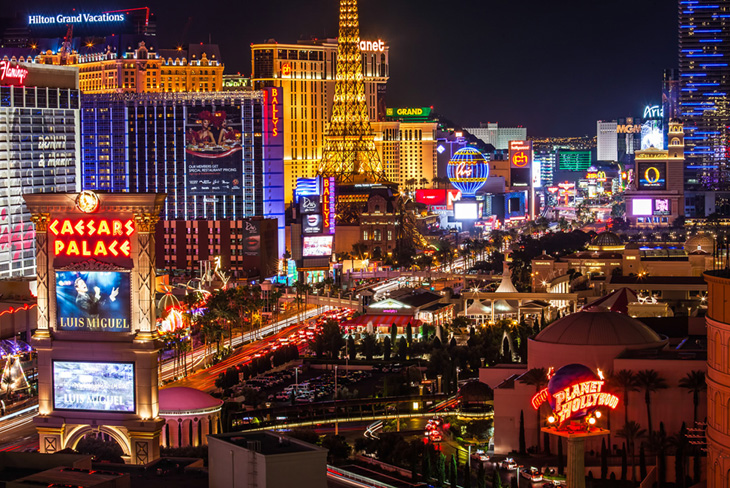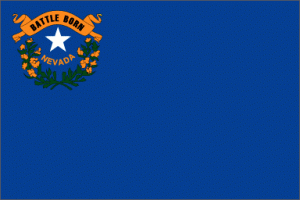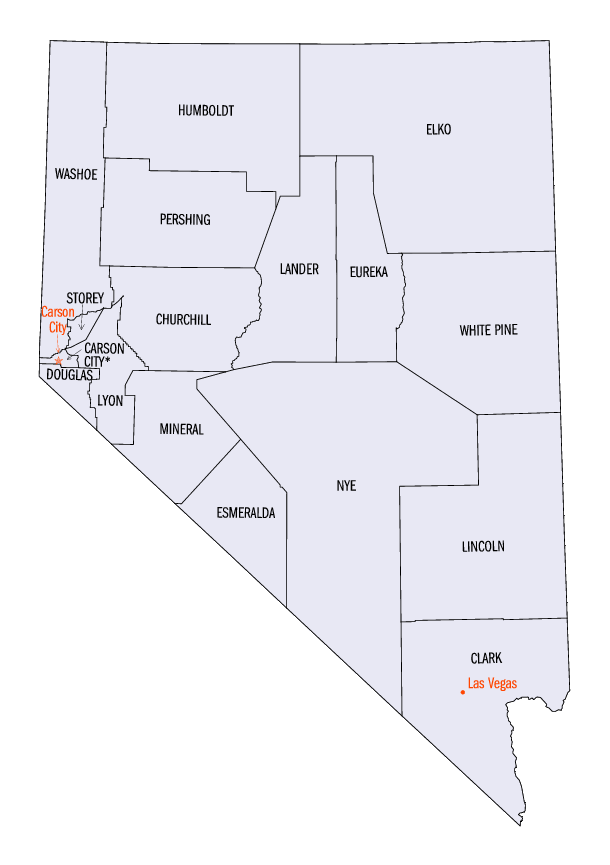
Nevada
 A state of the western United States. It was admitted as the 36th state in 1864. Part of the area ceded by Mexico to the United States in 1848, it became a separate territory in 1861 after an influx of settlers drawn by the discovery (1859) of the Comstock Lode. bordered by Oregon and Idaho to the north, Utah and Arizona to the east, and California to the south and west. Its capital is Carson City, and its largest city is Las Vegas. Economy: Agriculture: cattle, hay, dairy products, potatoes; Industry: tourism, mining, machinery, printing and publishing, food processing, electric equipment.
A state of the western United States. It was admitted as the 36th state in 1864. Part of the area ceded by Mexico to the United States in 1848, it became a separate territory in 1861 after an influx of settlers drawn by the discovery (1859) of the Comstock Lode. bordered by Oregon and Idaho to the north, Utah and Arizona to the east, and California to the south and west. Its capital is Carson City, and its largest city is Las Vegas. Economy: Agriculture: cattle, hay, dairy products, potatoes; Industry: tourism, mining, machinery, printing and publishing, food processing, electric equipment.
State stats
Nevada takes its name from a Spanish word meaning snow-clad.
State Abbreviation: NV
Capital City: Carson City
Date of Statehood: Oct. 31, 1864
State #: 36
State Population: 1,998,257
State Area: 110567 sq.mi. Land 109806 sq. mi. Water 761 sq.mi.
State Bird: Mountain Bluebird
State Flower: Sagebrush
State Motto: All for our country
State Nickname: The Sagebrush State/The Silver State
State Song: Home Means Nevada
 Flag of Nevada
Flag of Nevada
About the Flag: On a cobalt blue background in the upper left quarter is a five-pointed silver star between two sprays of sagebrush crossed to form a half wreath; across the top of the wreath is a golden scroll with the words, in black letters, “Battle Born.” The name “Nevada” is beneath the star in gold letters. The current Nevada State Flag design was adopted in 1929, and revised in 1991.
State symbols
Digitally colored elevation map of NevadaState animal: Desert Bighorn Sheep
State artifact: Tule Duck Decoy
State bird: Mountain Bluebird
State colors: Silver and Blue
State fish: Lahontan cutthroat trout
State flower: Sagebrush
State fossil: Ichthyosaur
State grass: Indian ricegrass
State march: “Silver State Fanfare” by Gerald Willis
State metal: Silver (Ag)
State motto: “All for our country”
State precious gemstone: Virgin Valley black fire opal
State semiprecious gemstone: Nevada turquoise
State song: “Home Means Nevada” by Bertha Raffetto
State reptile: Desert Tortoise
State rock: Sandstone
State soil: Orovada series
State tartan: A particular tartan designed for Nevada by Richard Zygmunt Pawlowski
State trees: Single-leaf Piñon and Bristlecone pine
History
In 14.08.1850, the U.S. Congress established the Utah territory which included the present day states of Utah, Idaho and Nevada. 1859 saw the discovery of the Comstock Lode, a rich outcropping of gold and silver, and Virginia City sprang up. This discovery brought a flood of miners, prospectors, merchants and others hoping to strike it rich.
On March 2, 1861, Nevada separated from the Utah territory and adopted its current name, shortened from Sierra Nevada (Spanish for “snowy range”). On October 31, 1864, just eight days prior to the presidential election, Nevada became the 36th state in the union. Statehood was rushed through despite Nevada’s tiny population to help ensure Abraham Lincoln’s reelection and post-Civil War Republican dominance in congress. As Nevada’s mining-based economy tied it to the more industrialized Union, it was viewed as politically reliable (as opposed to the more agrarian and Confederate-sympathizing California).
Nevada achieved its current boundaries on May 5, 1866 when it absorbed the portion of Pah-Ute County in the Arizona Territory west of the Colorado River. The transfer was prompted by the discovery of gold in the area, and it was thought that Nevada would be better able to oversee the expected population boom. This area includes most of what is now Clark County, Nevada.
Negotiations are currently underway for Nevada to annex Wendover, Utah, which would be merged with West Wendover, Nevada. This deal will require the permission of both the Nevada and Utah legislatures and the U.S. Congress.
Mining shaped Nevada’s economy for many years. In the late 1800’s, the Comstock Lode played out, and Nevada went into a tailspin. There was even talk of stripping away statehood, the only time in American history such an action was discussed in Congress. However, the rich silver strike at Tonopah in 1900 helped save the state. This was soon followed by strikes in Goldfield and Rhyolite in the following years. These strikes lasted well into the 1910s and made Nevada a dominant player in mining once again. Mines still control a good percentage of Nevada’s economy. Gold from the Carlin Trend in Northern Nevada is the second richest in the world. Other minerals, such as copper, molybdenum, and lithium, are also mined.
Despite Nevada being the third oldest western state, it is referred to as the “Permanent Colony” as over 87% of the land is owned by the Federal Government. The primary reason for this is that homesteads were not permitted in large enough sizes to be viable in the arid conditions that prevail throughout Nevada. Instead, early settlers would homestead land surrounding a water source, and then graze livestock on the adjacent public land, which is useless for agriculture without access to water (this pattern of ranching still prevails). The deficiencies in the Homestead Act as applied to Nevada were probably due to a lack of understanding of the Nevada environment, although some firebrands (so-called “Sagebrush Rebels”) maintain that it was due to pressure from mining interests to keep land out of the hands of common folk.
Gambling was common in the early Nevada mining towns, but was outlawed in 1909 as part of a nation-wide anti-gaming crusade. Due to a sharp decline in mining output in the 1920s and the decline of the agricultural sector during the Great Depression, Nevada re-legalized gambling in 1931. At the time, the leading proponents of gambling expected that it would be a short term fix until the state’s economic base widened to include less cyclical industries. However, re-outlawing gambling has never been seriously considered since.
A fictional history (with a great deal of fact) titled Nevada was written by Clint McCullough.

|
|||||||||||||||||||||||||||||||||||||||||||||||||||||||||||||||||||||||||||||||||||||||||||||||||||||||||
|
|
